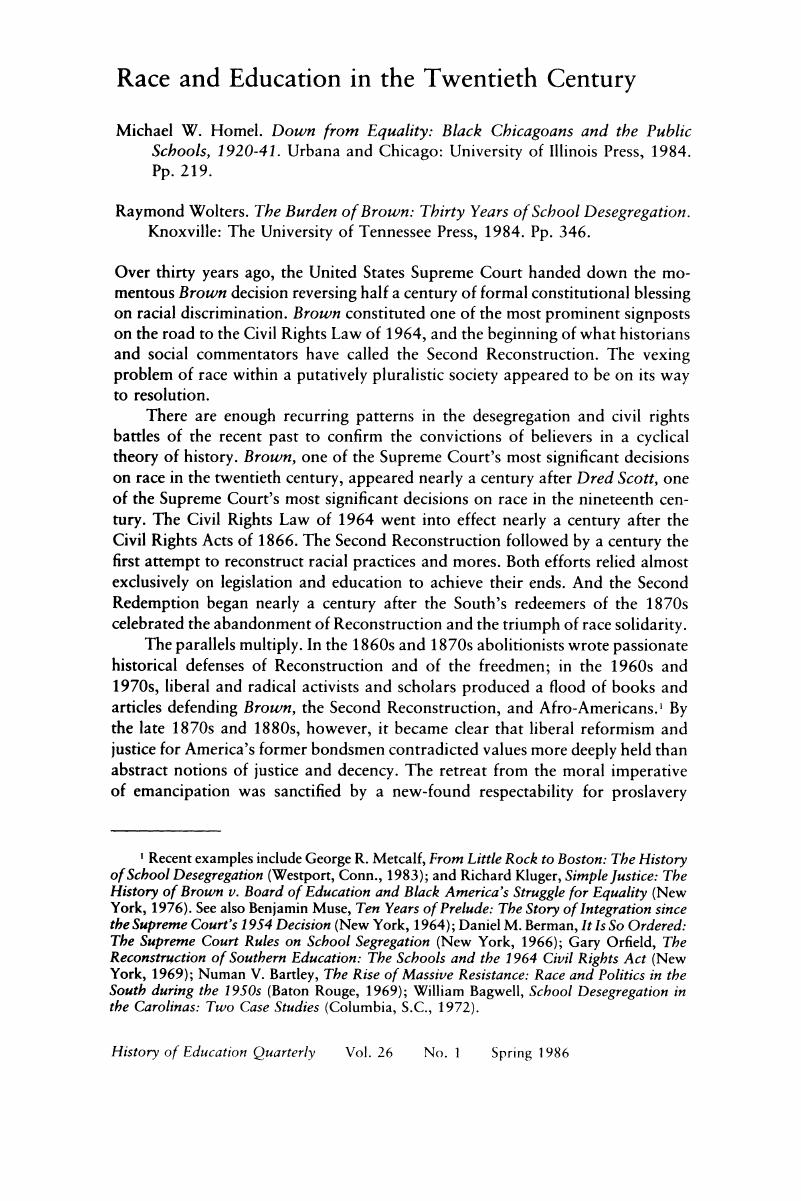No CrossRef data available.
Article contents
Race and Education in the Twentieth Century
Published online by Cambridge University Press: 24 February 2017
Abstract

- Type
- Essay Reviews
- Information
- Copyright
- Copyright © 1986 by the History of Education Society
References
1 Recent examples include Metcalf, George R., From Little Rock to Boston: The History of School Desegregation (Westport, Conn., 1983); and Kluger, Richard, Simple Justice: The History of Brown v. Board of Education and Black America's Struggle for Equality (New York, 1976). See also Muse, Benjamin, Ten Years of Prelude: The Story of Integration since the Supreme Court's 1954 Decision (New York, 1964); Berman, Daniel M., It Is So Ordered: The Supreme Court Rules on School Segregation (New York, 1966); Orfield, Gary, The Reconstruction of Southern Education: The Schools and the 1964 Civil Rights Act (New York, 1969); Bartley, Numan V., The Rise of Massive Resistance: Race and Politics in the South during the 1950s (Baton Rouge, 1969); Bagwell, William, School Desegregation in the Carolinas: Two Case Studies (Columbia, S.C., 1972).Google Scholar
2 Wolters, Raymond, The New Negro On Campus: Black College Rebellions of the 1920s (Princeton, N.J., 1975).Google Scholar
3 Cf. Willie, Charles V., School Desegregation Plans That Work (Westport, Conn., 1984), among many others. In contrast to Wolters, and on the basis of much less impressionistic evidence, Willie concludes that there is little correlation between white flight and school desegregation.Google Scholar
4 Garrett, Henry E., Breeding Down (Richmond, Va., 1966), quoted in Karier, Clarence J., “Testing for Order and Control in the Corporate Liberal State,” in Karier, , et al., Roots of Crisis: American Education in the Twentieth Century (Chicago, 1973), 118; see also for example, Garrett, Henry E., How Classroom Desegregation Will Work (Richmond, Va., 1965); Chase, Allan, The Legacy of Malthus: The Social Costs of the New Scientific Racism (Urbana, 1980), 154, 450, 455.Google Scholar
5 Kirby, John B., “The Ideological Struggles of Black Protest, 1954–1980,” unpublished essay, 1985.Google Scholar
6 Wolters notes that “many concerned parents wish above all to sequester their children from the pull of downward mobility” (p. 287). He chooses to interpret that fact exclusively in terms of a fear of “exposing their children to the black underclass,” however.Google Scholar
7 Kirby, , “Ideological Struggles,” 32.Google Scholar
8 See for instance Mabee, Carleton, Black Education in New York State: From Colonial to Modern Times (Syracuse, 1979); Perkins, Linda Marie, “Quaker Beneficence and Black Control: The Institute for Colored Youth, 1852–1903,” in New Perspectives on Black Educational History, ed. Franklin, Vincent P. and Anderson, James D. (Boston, 1978), 19–43; Franklin, Vincent P., The Education of Black Philadelphia: The Social and Educational History of a Minority Community, 1900–1950 (Philadelphia, 1979); Pieroth, Doris H., “With All Deliberate Caution: School Integration in Seattle, 1954–1968,” Pacific Northwest Quarterly 73 (April 1982): 50–61; and the citations below.Google Scholar
9 Mohraz, Judy Jolley, The Separate Problem: Case Studies of Black Education in the North, 1900–1930 (Westport, Conn., 1979); Daniel, Philip T. K., “A History of Discrimination against Black Students in Chicago Secondary Schools,” History of Education Quarterly 20 (Summer 1980): 147–62.Google Scholar


